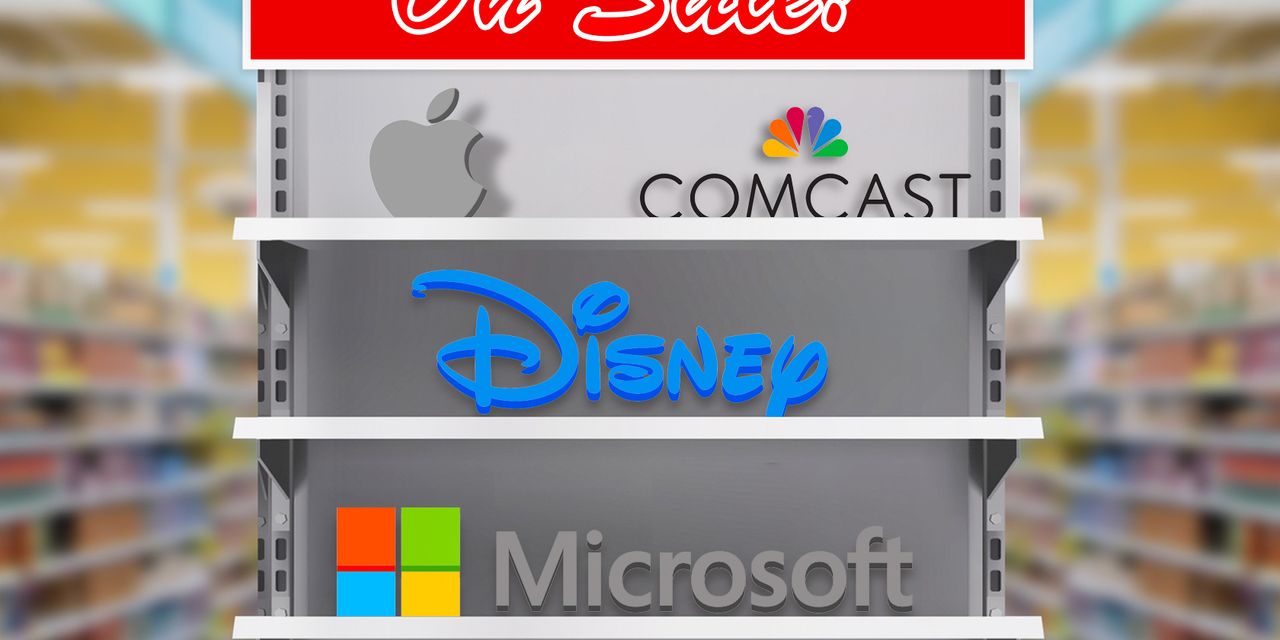Almost 1,500 high-grade corporate bonds issued by some household names are currently trading at a discount of between 50 and 80 cents on the dollar, offering investors with the right time frame the opportunity to pursue handy returns.
Bonds issued by Apple Inc., Microsoft Corp.
MSFT,
Google Parent Alphabet Inc.
GOOGL,
Walt Disney Co.
DIS,
and Comcast Corp.
CMCSA,
among others, are included in the list. That gives investors the chance to buy A-rated bonds at a steep discount that will pay out at par when they mature.
Winnie Cisar, head of global strategy at CreditSights, said it’s not a huge surprise to find these companies on the list, as the highest quality names are the ones that have access to the cheapest borrowing costs. And they were able to take advantage of that access during the long period of zero interest rates that preceded the current rate-hiking cycle. With the interest-rate cycle moving in the opposite direction now, investors can shop for discounted bonds already in circulation.
“ ‘For people looking for a high quality, but also high yielding investment, long-dated U.S. investment grade corporate bonds offer an attractive mix of regular coupon payments (which can be reinvested to compound gains), no near-term reinvestment risk and relatively little credit risk.’”
Apple
AAPL,
for example, issued $17 billion of bonds in 2013 to raise the funds for a $100 billion shareholder-return program. Apple preferred to borrow money at that time and avoid the 35% tax it would have had to pay on cash repatriated from overseas. Some $102 billion of its total cash pile of $144.7 billion was located overseas at the time.
The iPhone maker was able to issue 3-year bonds at just 20 basis points above the higher-rated, 3-year fixed-rate Treasury note, which was trading at 0.326% at the time.
Apple priced its 5-year notes at 40 basis points over the 5-year Treasury note, its 10-years at 75 basis points over the 10-year Treasury note and its 30-year bonds at 100 basis points over the 30-year Treasury bond, as MarketWatch reported at the time.
Apple has repeatedly tapped the bond market since then and achieved similarly low coupons. But now that Federal Reserve has raised its key federal-funds rate to a target range of 5.25%-5.5% in 11 moves started in March of 2022, those bonds have fallen in price, while their yields have moved above 5%. That’s because of the inverse relationship between bond prices and yields and not because of any credit quality issue.
“The only question then is whether these companies will still be around in 30 years,” said Cisar. “And most people would assume that Apple and Microsoft
MSFT,
and Johnson & Johnson
JNJ,
will.”
Cisar published a note on Tuesday pointing out the investment-grade yields globally are approaching their cycle highs at 5.9% in the U.S. and 4.4% in Europe, sending high-quality corporate bonds to their lowest levels since November of 2022, with double-digit-percent discounts to par across both markets.
See also: ‘It’s pretty dire,’ John Hancock strategist says of sentiment on Wall Street as bond yields march higher
The following chart from data solutions provider BondCliQ Media Services shows the number of U.S. investment-grade bonds that were trading between 50 and 80 cents on the dollar from Sept. one through Sept. 26.
The number peaked at 2,209 on Oct. 31 of 2022, when the U.S. 30-year Treasury hit 4.30%.
The 30-year is now pushing 4.70% and as the line graph shows, the daily bond count is at its highest since the 2022 peak at 1,432. And spreads have tightened by a wide margin in the interim period.
Daily number of unique high grade bonds trading between 50 and 80 cents on the dollar. Source: BondCliQ Media Services
It’s an investment that has clearly caught on. The following chart shows the volume of trade over the last 10 days by trade type, revealing a healthy mix of buying and selling on solid volume.
Investment-grade bonds with average price of $50 to $80 shown as volume by trade type over last 10 trading days. Source: BondCliQ Media Services
The next table highlights high-quality names from the Technology, Media and Telecom sectors and includes their stock tickers.
Investment-grade bonds with average price between $50 and $80. Source: BondCliQ Media Services
Smaller investors, including individual retail investors, can take advantage of these discounted bonds in a variety of ways, Cisar said.
They can buy single-name bonds by going through a broker, including discount brokers like Charles Schwab Corp.
SCHW,
or ETrade
MS,
“You can place orders on a single name, as long as it’s a public registered bond and not part of the private markets,” she said
A mom-and-pop investor may not get the same pricing as an institutional investors given the difference in order size, but should be able to get close to the current discounts, said Cisar.
Investors can also add long-dated corporate bonds to their portfolios using mutual funds or an exchange-traded fund like the iShares 10-year Investment Grade Corporate Bond ETF
IGLB.
Investors should bear in mind they will be taxed on interest income and capital gains if they buy and sell bonds, so they will need to consider a tax strategy.
But they don’t need to go too far out the maturity curve; there are high-grade 10-year bonds also trading at discounts that will pay out in full when they mature. That might be helpful for parents saving for a child’s college education, for instance.
“For people looking for a high quality, but also high yielding investment, long-dated U.S. investment grade corporate bonds offer an attractive mix of regular coupon payments (which can be reinvested to compound gains), no near-term reinvestment risk and relatively little credit risk,” said Cisar.
See also: ‘Magnificent Seven’ stocks are losing some of their shine, but their bonds are doing fine
Read now: With myriad banks dangling 5% and up offers, here are 10 things to know before buying a CD
Read the full article here










